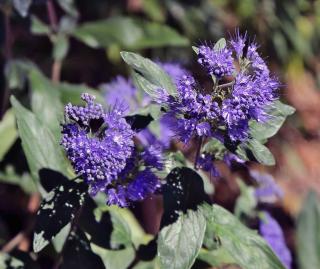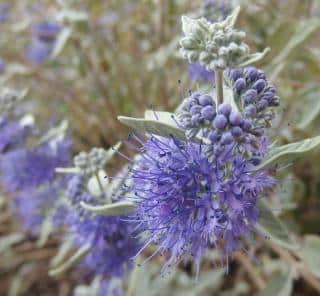

Caryopteris, also called bluebeard, is a shrub that is unique thanks to its blooming.
Core Caryopteris facts
Name – Caryopteris x clandonensis
Family – Lamiaceae
Type – shrub
Height – 5 feet (1.5 meters)
Exposure – full sun
Soil – rather rich
Foliage – deciduous – Flowering – Summer/Autumn
Caryopteris is a flower shrub that is preferably planted in fall or spring, and even in summer if purchased in a container.
Its resistance to the cold and to freezing is low, since it suffers when the temperature drops below 23°F (-5°C).
You can plant caryopteris in fall, provided that winter isn’t too cold in your area, especially for those varieties that tend to be sensitive to the cold.
Caryopteris isn’t too demanding as regards the quality of the soil, but proper planting will ensure good settling in, better development and abundant blooming.
 Caryopteris likes light and well drained soil types, even poor ones.
Caryopteris likes light and well drained soil types, even poor ones.Making cuttings in summer is the easiest and fastest method to propagate caryopteris.
Caryopteris is a plant that requires little care, even if some practices when seen through will extend the blooming and protect it in winter.
Very resilient in the face of drought, cold and most diseases, caryopteris is a hardy ornamental plant.
It also fares well when grown in pots, especially if it freezes strongly in your area and you can bring it in for shelter in winter.
When in pots, you’ll also have to remember to water when the surface of the soil is dry.
 Light mulch avoids weed growth and retains moisture in the soil.
Light mulch avoids weed growth and retains moisture in the soil.As mentioned above, pruning consists in cutting the caryopteris back after the blooming and covering the plant with a thick layer of leaves.
If the climate in your area is harsh, wait for spring before pruning.
Caryopteris, sometimes called bluebeard, is remarkable for its unique blooming in fall, the color of its flowers but also its fragrant leaves.
 There are many varieties, like the ‘White surprise’ or the ‘Summer sorbet’ and the plant is easily recognizable by checking on its superb mottled leafage. There also are pink varieties such as the ‘Autumn pink’.
There are many varieties, like the ‘White surprise’ or the ‘Summer sorbet’ and the plant is easily recognizable by checking on its superb mottled leafage. There also are pink varieties such as the ‘Autumn pink’.
Shown here are pictures of the ‘Dark Knight’ Caryopteris and the ‘Lissilv Sterling Silver’, which has silvery foliage.
 It grows to form a shrub that gives a flower bed a round and colorful touch, and is particularly well-liked by butterflies and bees that visit it repeatedly.
It grows to form a shrub that gives a flower bed a round and colorful touch, and is particularly well-liked by butterflies and bees that visit it repeatedly.
There are many caryopteris hybrids, even if these are reputed to be more vulnerable to freezing.
Although this plant it easy to grow, it does ask to be set in a spot that is sheltered and endowed with sun. No diseases have been reported to infect it.
Mulch will protect the caryopteris from freezing when winters are cold.